Installing and Setting Up Microsoft SQL Server Express
About this task
This section provides information for administrators inexperienced with Microsoft SQL Server. The following steps assume you do not have Microsoft SQL Server installed. The following steps will guide you through downloading and configuring the free Microsoft SQL Server Express edition.
Step 1: Downloading and Installing Microsoft SQL Server Express and Microsoft SQL Server Management Studio
Before you begin
- Decide where to install Microsoft SQL Server.
Procedure
-
Download Microsoft SQL Server 2019
Express to your local machine.
Troubleshooting: If you face installation issues, update Windows and reboot. Repeat updating and rebooting until there are no more updates to install.Note: You may need to restart Microsoft SQL Server more than once to ensure the security changes take effect during the installation process.
- Run the Microsoft SQL Server Express installer .exe file on your local machine.
-
Select the Basic installation type to download Microsoft SQL Server Express and all related utilities.
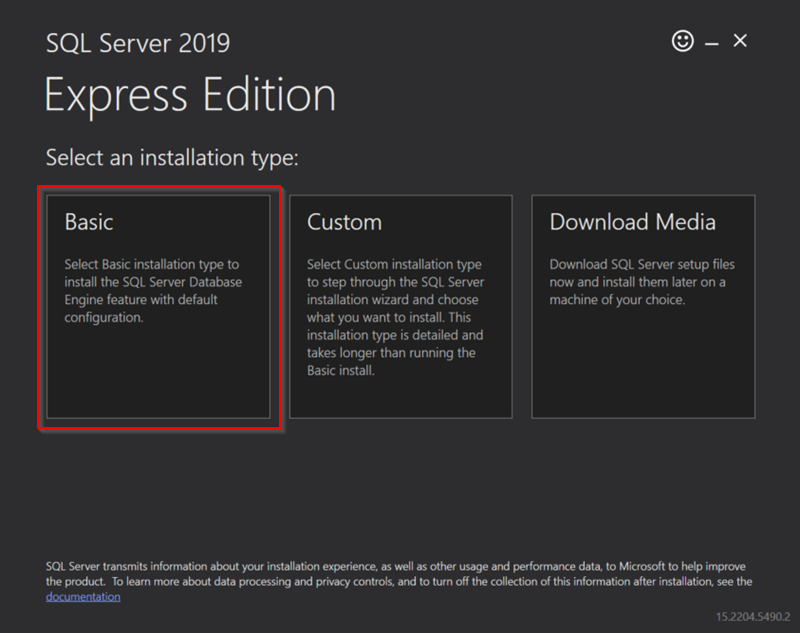
-
Accept the license terms and conditions. Keep the default installation
location (on the C: drive), then select
Install.
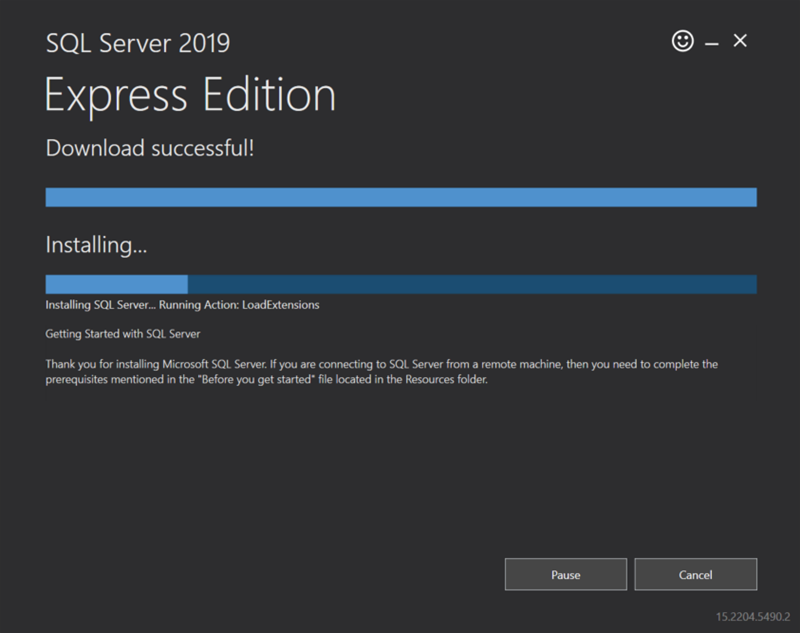 The installer downloads and installs all the required Microsoft SQL Server Express packages. When everything has completed successfully, a notification page similar to the following displays:
The installer downloads and installs all the required Microsoft SQL Server Express packages. When everything has completed successfully, a notification page similar to the following displays: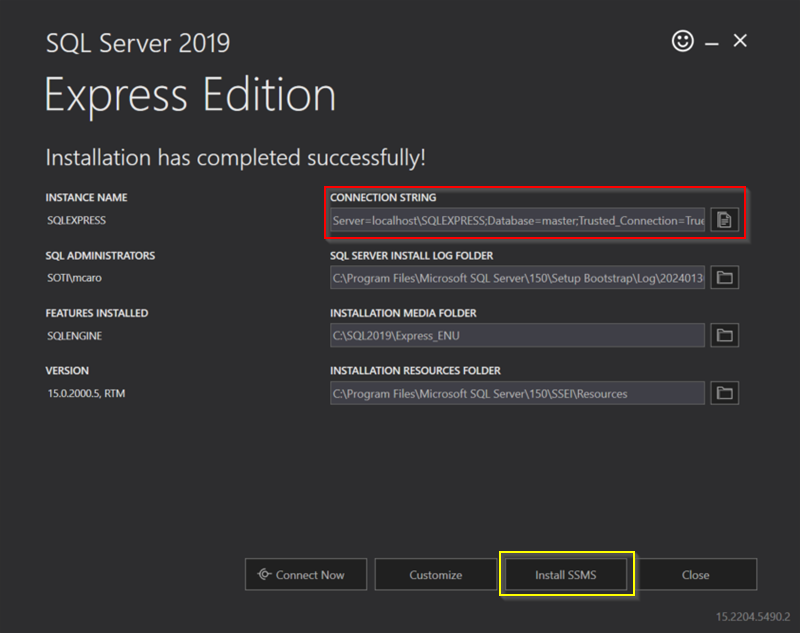 Important: Take note of the
Important: Take note of theServervalue in the Connection String field (red box). You need it when installing SOTI Connect - On the installation successful notification page, select the Install SSMS button (yellow box in screenshot above) to download and install Microsoft SQL Server Management Studio.
- When the Microsoft SQL Server Management Studio installation .exe file finishes downloading, run the .exe file. In the installer window, select where you want to install the Microsoft SQL Server Management Studio. Keep the default installation location on the C: drive.
-
Select Install.
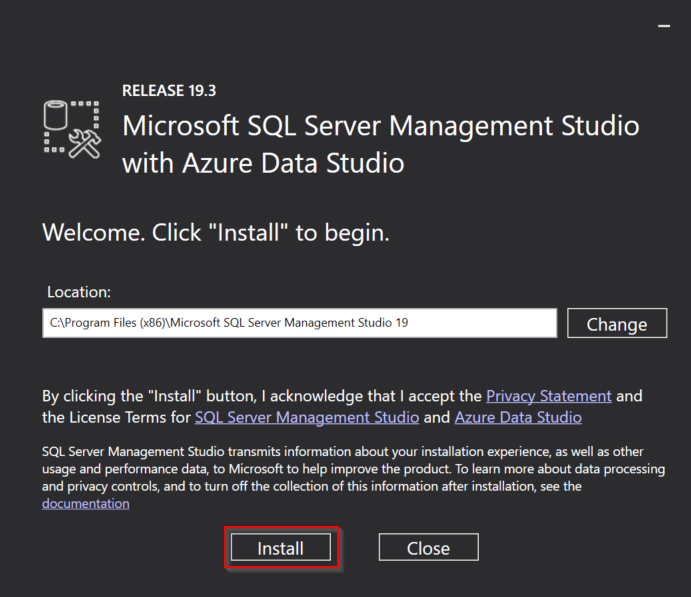 When the installation completes, the Setup Completed screen displays.
When the installation completes, the Setup Completed screen displays. - Close all applications and restart the server or Virtual Machine (VM).
Step 2: Configuring Microsoft SQL Server to Work with SOTI Connect
Procedure
- Open the Microsoft SQL Server Management Studio.
-
Establish a connection to the Microsoft SQL Server instance by
entering the
Servervalue in the Connection String you noted in Step 4 of Downloading and Installing Microsoft SQL Server Express and Microsoft SQL Server Management Studio section. -
Select Connect.
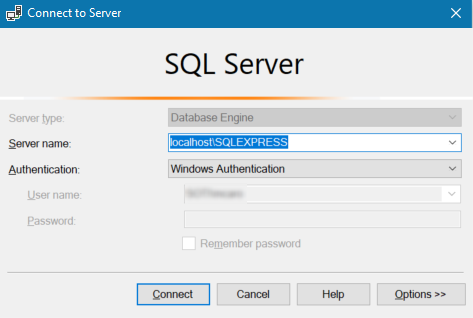
-
Microsoft SQL Server connects successfully, and the instance name
displays.
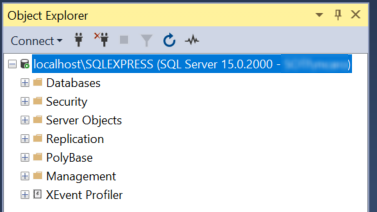
-
Right-click the instance name and select
Properties.
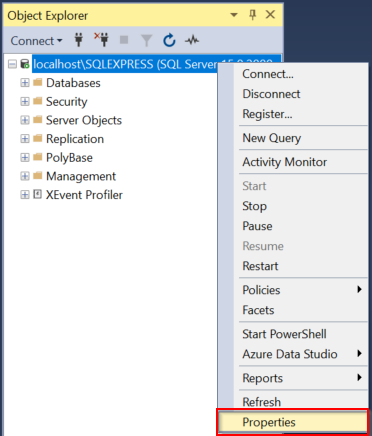
- In the left panel, select Security.
-
In the Server Properties panel, select SQL
Server and Windows Authentication mode in the
Server authentication section. Select
OK to save your changes.
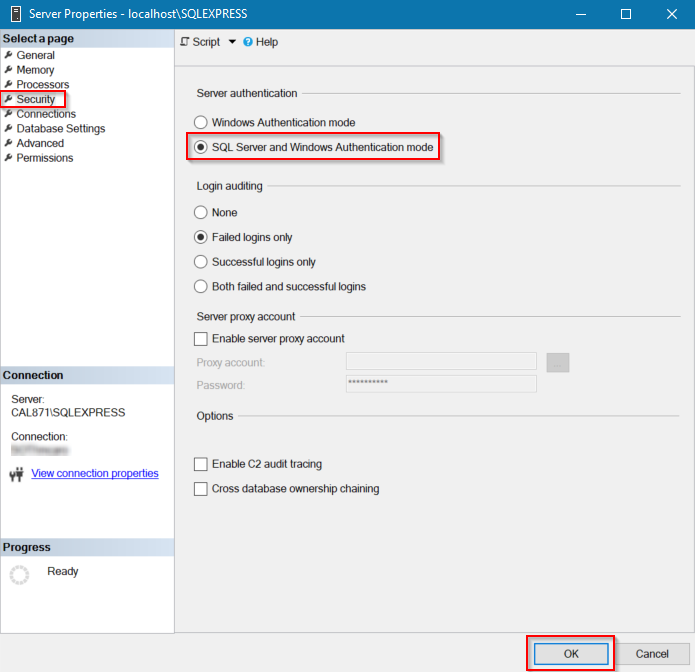
- Decide whether you want to use a local SQL account or a Windows account for authentication. The following steps describe configuring a local account.
- Expand the Security folder and right-click Logins.
-
Select New Login.
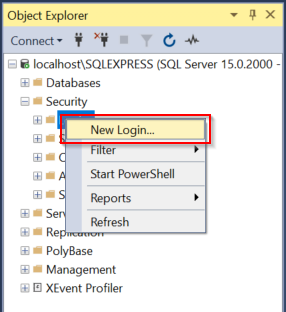
- Enter a Login name, in this example Login name is SQLConnect.
-
Select SQL Server authentication, and create a
password for the login.
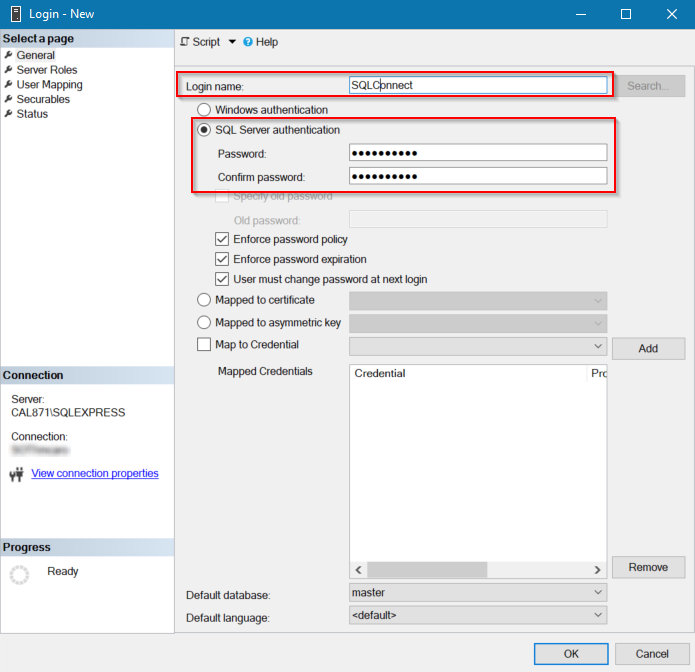
-
In the left panel, under Server Roles, select the
sysadmin checkbox and select
OK.
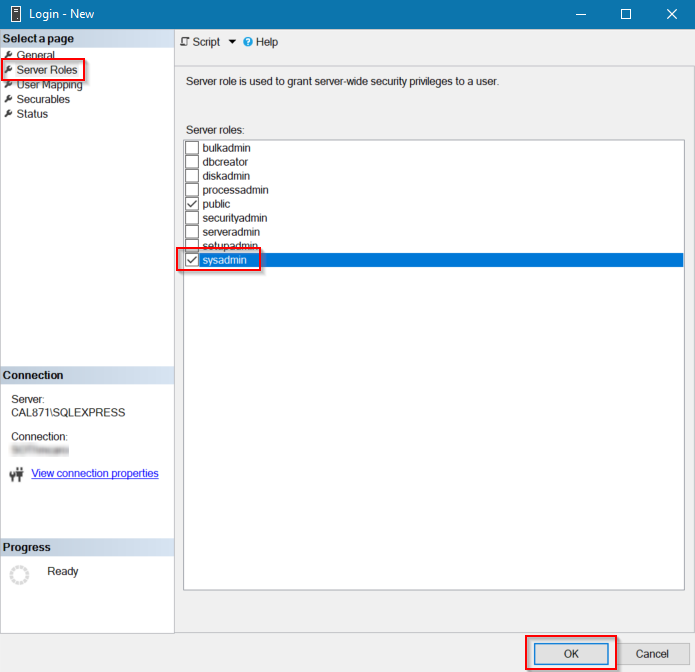
-
Under the Logins header in the left panel, the setup
automatically creates a new local login account.
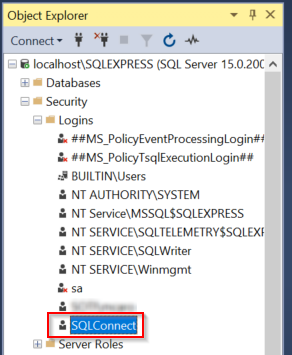 Important: Use this login for your database when you install SOTI Connect.
Important: Use this login for your database when you install SOTI Connect. -
Check NT AUTHORITY\SYSTEM has the
sysadminrole assigned to it. Right-click NT AUTHORITY\SYSTEM and select Properties. Select the sysadmin checkbox under Server Roles.Important: Use this login if installing SOTI Connect using Windows Authentication. If the database runs on a remote server, the login will not beNT Authority\System. It will be theMachineName$(for example,domainname\computername). - Keep Microsoft SQL Server Management Studio running, then run the Microsoft SQL Server Configuration Manager utility, included as part of Microsoft SQL Server Express.
-
In the Microsoft SQL Server Configuration Manager utility, expand
SQL Server Network Configuration and select
Protocols for SQLEXPRESS.
Note: Select the correct protocol for your SOTI Connect instance if it is different than Protocols for SQLEXPRESS.
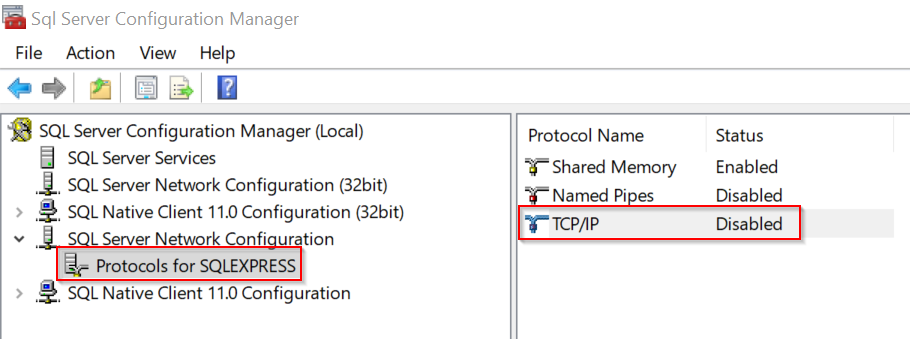
- Right-click the TCP/IP protocol and enable the TCP/IP protocol.
- Right-click the TCP/IP protocol again and then select Properties. The TCP/IP Properties panel displays.
-
In the TCP/IP Properties panel, select the
IP Addresses tab, empty any IP TCP
Dynamic Ports fields and set the
to
1433.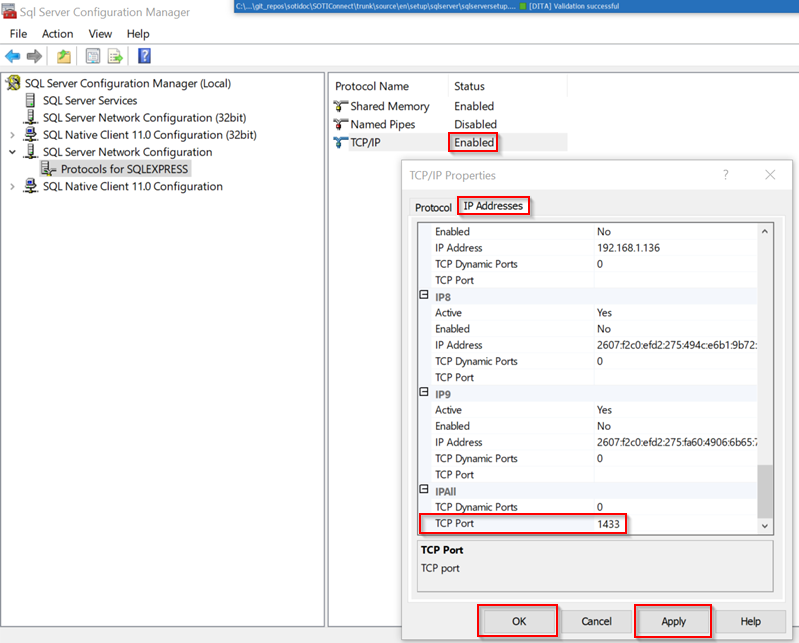
- Select Apply, then select OK.
- Restart your Microsoft SQL Server instance and Microsoft SQL Server Management Studio to apply your changes.
SQL Server Security Notes
The installation of SOTI Connect requires more database privileges than needed for regular working operations. You should reduce the level of access after the installation of Microsoft SQL Server is complete. Use the following table to reference the required access levels after the installation is complete.
| Operation | Required Database Privileges |
|---|---|
| Installing or upgrading | Sysadmin. The SA account is a super admin
with permissions for any scenario. |
| Normal working operation | db_owner. |
| Service running as a local system with DB installed on the same server | Local System > NT AUTHORITY\System.The service runs on the computer with this permission. Note: NT needs
Sysadmin during an upgrade. |
| Service running as a local system with the DB installed on a remote server | db_owner.Using Microsoft SQL Server, add the user or the group
containing the user to the Note: The database does not use the
local system or
NT AUTHORITY\System,
but becomes MachineName$ (for example,
domainname\computername). |
| Service running as a service account | Make sure the user account is also in the DB as an account
with the correct permissions. For example, if the user account
|
If you used the Microsoft SQL Server authentication option (for
example, when you created the SQLConnect login in the example above), you should
remove the sysadmin role after completing the SOTI Connect installation. You should also confirm that the
SQLConnect login has the db_owner user mappings for all the
SOTI Connect databases.
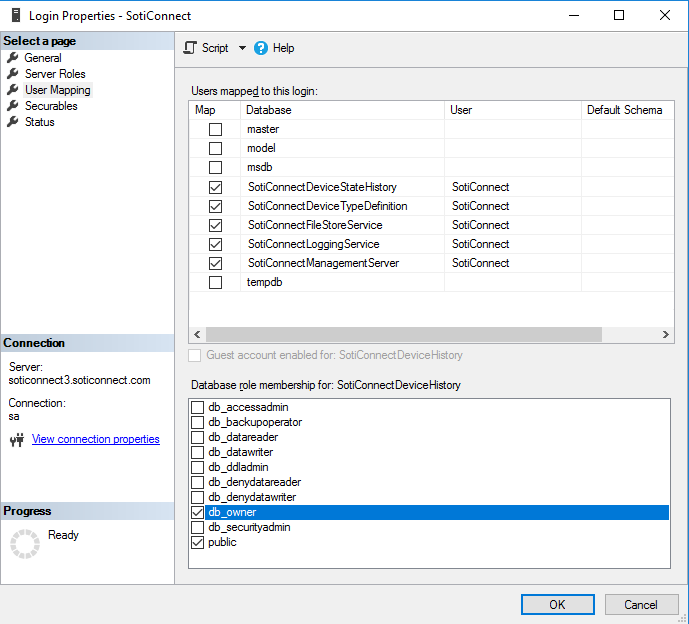
sysadmin role to the SQLConnect user before running the
SOTI Connect installer again.If you used the
Windows authentication method to install SOTI Connect, you
should remove the sysadmin role from the NT
AUTHORITY/SYSTEM login. You should also confirm that this login has
db_owner user mappings for all the SOTI Connect databases.
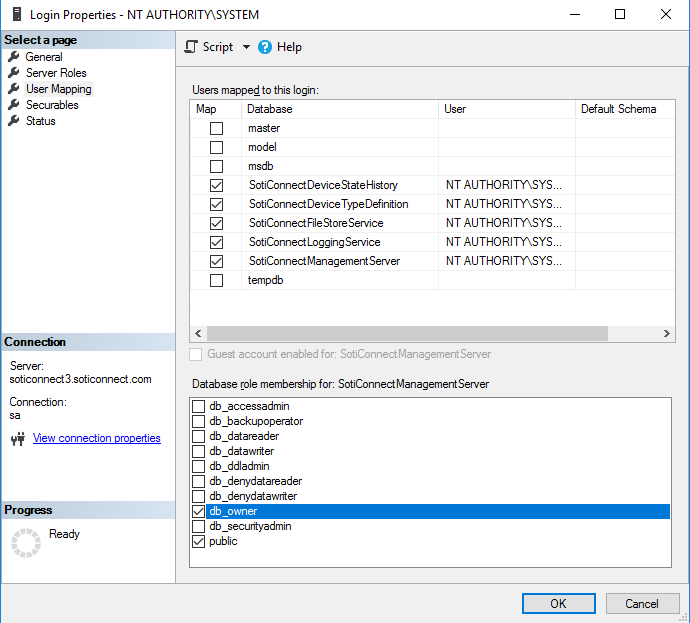
SotiConnectDeviceStateHistory and
SotiConnectLoggingService databases.You should also remove the
sysadmin role from the user who ran the SOTI Connect installer. You must restore the
sysadmin role to that user before running the SOTI Connect installer again.